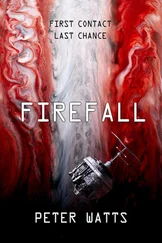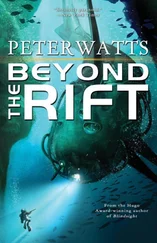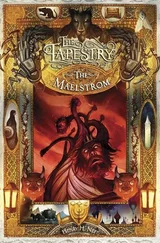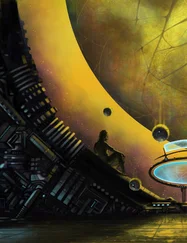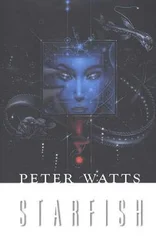It was called Haven, and Achilles Desjardins practically lived there.
Now he was spinning a web across one pristine corner of his playground. Rowan's biochemical stats had already been sent to Jovellanos's station: the first thing he did was establish an update link. Then he looked over the ramparts, peeking past the shoulders of the vigilant gels into Maelstrom proper. There were things out there that had to be brought inside—carefully, though, mindful of the sparkling floors:
Tap into EOS archives. Get daily radar maps of soil moisture for the past year, if available. (A big if , these days. Desjardins had tried to load a copy of Bonny Anne from the library the week before, only to find they'd started wiping all books that hadn't been accessed for more than a two-month period. The same old mantra: storage limitations.) EM snaps of polyelectrolytes and complexing cations. Multispectrals on all major chlorophylls, xanthophylls, carotenoids: iron and soil nitrogen, too. And just to be thorough—without much hope, mind you—query the NCBI database for recent constructs with real-world viability.
Competing with conventional primary producers, Rowan had said. Meaning the conventional bugs might be dying off: do a spectral for elevated soil methane. Distribution potentially temperature-limited; infrared, crossed with albedo and windspeed. Restrict all searches to a polygon extending from the spine of the Cascades out to the coast, and from Cape Flattery down to the thirty-eighth parallel.
Draw the threads together. Squeeze the signal through the usual statistical gauntlet: path analysis, Boltzmann transforms, half-a-dozen breeds of nonlinear estimation. Discriminant functions. Hankins filters. Principal component analysis. Interferometry profiles across a range of wavelengths. Lynn-Hardy hyperniche tables. Repeat all analyses with intervariable time-lags in sequence from zero days to thirty.
Desjardins played at his panel. Abstract shapes condensed from diffuse clouds of data, winked provocatively at the corner of his eye, vanished the moment he focused on them. Fuzzy white lines from a dozen directions interwove, colored, took on intricate fractal patterns—
But no. This mosaic had a P value greater than 0.25; that one violated assumptions of homoscedasticity. The little one in the corner drove the Hessians fucking crazy . One flawed thread, barely visible, and the whole carpet unraveled. Tear it down, bleach out the transforms, start from scratch—
Wait a minute .
Correlation coefficient of -0.873. What was that all about?
Temperature. Temperature went up when chlorophyll went down.
Why the hell didn't I see that before? Oh, there. A time-lag. What the…
What the …
A soft chime in his ear: "Hey Killjoy. I've got something really strange here."
"Me too," Desjardins replied.
* * *
Jovellanos's office was just down the hall; it still took her a few minutes to show up at his door. The caffeine spike clenched in her hand told him why.
"You should get more sleep," he remarked. "You won't need so many chemicals."
She raised an eyebrow. "This from the man with half his bloodstream registered in the patent office." Jovellanos hadn't had her shots yet. She didn't need them in her current position, but she was too good at her job to stay where she was much longer. Desjardins looked forward to the day when her righteous stance on the Sanctity of Free Will went head-to-head against the legal prerequisites for promotion. She'd probably take one look at the list of perks and the new salary, and cave.
He had, anyway.
He spun his chair back to the console and brought the correlation matrix up on the display. "Look at this. Chloroes go down, soil temperature goes up."
"Huge P-value," Jovellanos said.
"Small sample size. That's not the point: look at the time-lag."
She leaned forward. "Those are awfully big confidence limits."
"The lag's not consistent. Sometimes it takes a couple of days for the temp to rise, sometimes a few weeks."
"That's barely even a pattern , Killjoy. Anything-"
"Take a guess at the magnitude," he broke in.
"Loss of plant cover, right?" Jovellanos shrugged. "Assuming it is a real effect, say half a degree? Quarter?"
Desjardins showed her.
"Holy shit," she said. "This bug starts fires ?"
"Something does, anyway. I scanned the municipal archives along the coast: all local firestorms, mostly attributed to acts of terrorism or 'industrial accidents'. Also a couple of tree farms going down for some agro pest—budworm or something."
Jovellanos was at his elbow, her hands running over his console. "What about other fires in the area…"
"Oh, lots. Even keeping strictly within the search window, I found a good eight or nine that didn't correlate. A ties to B , but not vice versa."
"So maybe it's a fluke," she said hopefully. "Maybe it doesn't mean anything."
"Or maybe somebody else has a better track on this bug than we do."
Jovellanos didn't answer for a moment. Then: "Well, we might be able to improve our own track a bit."
Desjardins glanced up. "Yeah?"
"I've been working up that sample they gave us. They're not making it easy, they haven't left a single intact organelle as far as I can tell—"
He waved her on: "It all looks the same to a mass spec."
"Only if they left all the pieces behind after they mashed them."
"Of course they did. Otherwise you'd never get an accurate sig."
"Well, I can't find half the stuff that's supposed to be there. No phospholipids, even. Lots of nucleotides, but I can't get them to fit a DNA template. So your bug's probably RNA-based."
"Uh-huh." No surprises there—lots of microbes got along just fine without DNA.
"Also I've managed to reconstruct some simple enzymes, but they're a bit too stiff in the joints to work properly, you know? Oh, and this is kind of weird: I've found a couple of D-aminos."
"Ah." Desjardins nodded sagely. "That means what, exactly?"
"Right-handed. The asymmetric carbons stick off the wrong side of the molecule. Like your usual left-handed amino, only flipped."
A mirror image. "So?"
"So that makes 'em useless; all metabolic pathways have been geared for L-aminos and only L-aminos, for the past three billion years at least. There's a couple of bacteria that use R-aminos because they're useless—they stick them onto their cell walls to make 'em indigestible—but that's not what we're dealing with here."
Desjardins pushed back in his chair. "So someone built this thing completely from scratch, is that what you're saying? We've got another new bug on our hands."
Jovellanos shook her head, disgusted. "And that corpse didn't even tell you."
"Maybe she doesn't know."
Jovellanos pointed at the GIS overlay. Two dozen crimson pinpoints sparkled along the coast from Hongcouver to Newport. Two dozen tiny anomalies of soil and water chemistry. Two dozen visitations from an unknown microbe, each presaging a small fiery apocalypse.
" Somebody knows," Jovellanos said.
On all sides Hongcouver licked its wounds.
The city had always been a coward, hiding behind Vancouver Island and a maze of local bathymetry. That had spared it from the worst effects of the tsunami. The quake itself had been another story, of course.
In an earlier day, before Maelstrom and telecommuting and city centers half-abandoned, the death toll in the core would have been three times as high. As it was, those who'd been spared vivisection downtown had merely died closer to home. Whole subdivisions, built on the effluvial sediment of the Fraser Delta, had shuddered into sudden quicksand and disappeared. Richmond and White Rock and Chilliwack didn't exist any more. Mount Rainier had awakened overnight in a bad mood; fresh lava continued to flow over most of its southern face. Mount Adams was stirring and might yet blow.
Читать дальше


